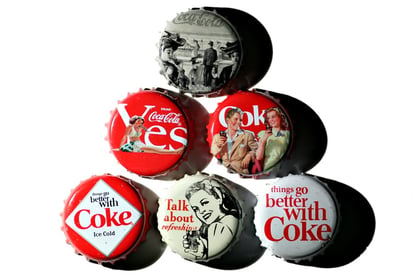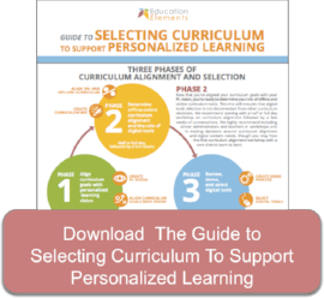When you mention being from Atlanta, the first thing most people ask you -- after the prerequisite “But you don’t have an accent!” -- is “Oh, I bet someone in your family worked for Coca-Cola!” Interestingly enough, for both of us, that’s actually true. Both of our fathers worked for Coca-Cola for the majority of their careers.
The philosophies and strategies of the Coca-Cola Company played a large role in our upbringing and now shape our work as leaders of personalized learning. We've crafted 5 lessons inspired by Coca-Cola which we hope you will find useful, no matter where you are on your personalized learning journey.
Lesson #1: Personalization is a driving force today in our lives.
When Coca-Cola was first created in 1886, there was a single flavor and a single delivery method: good ol' plain Coke in a glass bottle. With the advent of the soda fountain in the 1950s, consumers gained a few more options but were still reliant on needing someone else to create any custom flavors by pouring it for them behind the counter. Today, the Coca-Cola “Freestyle” machine allows you to mix up obscure flavors, on demand. Want vanilla coke with orange? No problem.
Personalization doesn’t end with the sodas we drink. Today’s students are growing up in a world where they can personalize most aspects of their life. Want to listen to music? Spin up a custom playlist in Spotify. Bored with live tv? Netflix will recommend something you'll love that you can watch anytime, anywhere. Need new shoes? Design your own.
When you really think about it, it is easy to see that students today can personalize just about everything...except school. There’s a big disconnect between what happens at school and what happens during the rest of our students’ lives, and that disconnect is causing our students to disengage. One student may need self-serve Vanilla Coke with Orange Soda while another needs Diet Sprite, but at school the only flavor they have access to is plain Coke.
Lesson #2: The factory model works for creating a Coke, but it doesn’t work for creating a learner.
The traditional method of teaching was created to meet the needs of the industrial revolution. At the time, knowledge was scarce and there needed to be a standardized system of education to turn kids out in batches of identical factory workers who could create plain Coke. Teachers were the sole source of knowledge and activities in the classroom.
The world has changed dramatically in the past 100+ years, but little has changed in our educational system. Teachers are no longer the sole source of knowledge -- just ask Siri. Today, information is ubiquitous, easy to access, and exponentially expanding. In order to meet the demands of the workforce today, K-12 education needs to focus on the skills that students cannot learn by Googling the answer. We need to focus on providing students opportunities to engage in interesting activities that ignite curiosity and result in self-direction, goal-setting, critical thinking, and problem-solving.
As a teacher, Heather’s students were engaged, in the sense that they were on task and they were learning the material. They were extremely high-achieving and exceeded traditional measures for academic success. But despite the fact that they were doing well, they really “plugged in” when they were at home, able to pursue their own interests and be creative. They went online to learn about the things that interested them and they spent large amounts of time truly engaged in learning and creating digital content.
Heather wanted to find a way to tap into her students’ drive to learn while they were at school, and began to research strategies to leverage this afterschool exploration. Scott McLeod calls this idea ‘Extracurricular Empowerment’ in his speech at TEDxDesMoines. But it no longer has to happen just after school.
Lesson #3: It is crucial to get in touch with your “why.”
Very few people really love change. Change is hard, and most of us tend to seek ways to stay within our comfort zone. In general, we will keep doing the same thing until the pain of the status quo becomes greater than the pain of change. So the question then becomes, how do we inspire people to take action toward change?
The answer starts with “why.” Simon Sinek explains that when we start with why, we speak directly to the part of the brain that controls human behavior and decision making.
In 1866, Coca-Cola came out with its first slogan to try to describe its “why": “Delicious and Refreshing.” In the 130 years since, the company has cycled through over 50 different iterations on its slogan. Whether the approach was simple (“Drink Coca Cola,” 1904), profound (“Open Happiness,” 2009), or historical (“The Great National Temperance Beverage, 1906”) it is evident that the Coca-Cola Company has continually revisited its “why.” As an aside, our slogan favorites are: “Pure as Sunlight; Around the Corner from Everywhere” (1927) and “The Only Thing Like Coca-Cola is Coca-Cola Itself” (1942).
Our "why" is simple: we believe that students deserve a personalized learning experience. Personalized learning encourages students to express their voice and drive their own education. It encourages students to engage in the conversation about how they learn best and recognizes that there are many paths to one destination. In our opinion, students have the right to demand a new way of learning. It isn’t just something that would be a nice benefit to education; it is something that must happen in order to meet the needs of all learners.
Anthony Kim speaks to this belief that students deserve a personalized learning experience as one of the central tenets of what he calls the “Personalized Learning Mindset.” This belief is our “why.” It is what motivates us to keep going when change is difficult. It is what drives us, and it is ultimately what helps us to inspire others to want to change too.
Lesson #4: There is no secret ingredient to personalized learning.
At the World of Coca-Cola in Atlanta, you can visit The Vault, an exhibit to learn more about Coca-Cola’s secret ingredient, called 7X. Teachers we work with are always looking for the 7X of personalized learning and asking us “what’s the right way?” The answer is that there are many paths to personalized learning.
In Fulton, we’ve identified seven principles of personalized learning to help schools answer that question for themselves. These principles are the foundation around which we anchor our work. However, the path that each school takes looks different than the path of any other school in the district. Fulton County Schools is one of the largest school districts in Georgia, serving 101 schools and over 96,000 students. The district spans 70 miles from north to south and serves a very diverse student population, ranging from very high achieving students to students who are struggling and behind in their learning. As a result, the needs of our schools are drastically different from one to the next.
As we have worked to personalize learning for students in Fulton, we have also worked to make it a personalized journey for our schools as well. Each school begins by creating their vision for personalized learning and identifying their “why.” Once the school has gotten in touch with why they want to personalize learning they set about developing their ideas about which of the seven principles they will focus on, and how they will adjust instruction to meet the needs of their learners.
One high-achieving high school decided that they needed to encourage students to self-advocate and to take more ownership of their daily learning.” Because student engagement was an area of focus, that school decided to highlight varied instructional strategies, just-in-time teaching, and voice and choice.
At another school, their “why” was to “close academic gaps and provide equal access to instructional technology for all students.” This school decided to leverage varied strategies and flexible pacing, with a focus on utilizing data and adaptive digital content to tackle their goals. As you can see, there isn’t a single secret formula for personalized learning.
Lesson #5: Personalized learning isn’t “New Coke.”
It isn’t going away. It’s not a fad. It’s not a rebranding of differentiation. While differentiation has attempted to meet the needs of individual learners, it has often been prescriptive by the teacher. In contrast, personalized learning is a more student-driven approach, about tailoring learning to each student’s needs, interests, and skills. It is about engaging students in a conversation about their learning and allowing them to participate as partners in their education.
In 1929, Archie Lee of the Coca-Cola Company came up with the slogan “The Pause that Refreshes,” and the saying took off. Today, we often use the term “refresh” to signify a reboot of technology. It is our belief that personalized learning has the power to be “The Pause that Refreshes” how we think about learning and teaching. Let’s take advantage of this opportunity to pause and reflect about the needs of today’s learners. From there, we can reboot and redefine the way we do school.

--
Heather Van Looy is the Instructional Technology Program Specialist for Fulton County Schools, in Atlanta, GA. She has been an educator for 18 years. In her current role she oversees the implementation and support of personalized learning for all schools in the district. Prior to working in the district office, Heather led the personalized learning initiative at River Trail Middle School. Having both school level and district level experience gives her a unique perspective on Fulton’s personalized learning journey.
Dana Britt is a Design and Implementation Consultant for Education Elements. She supports Heather and the amazing Fulton team in their transition to personalized learning. Prior to supporting Fulton and multiple other districts that partner with Education Elements, Dana worked in the DC Public Schools district office supporting the rollout of blended learning as well as teaching 9th grade ELA. She lives in Washington, DC, but loves to visit her hometown as much as possible for the Coca-Cola and Chick-fil-A.




